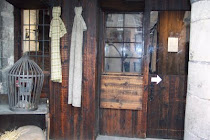The final room in The Tenement is going to need a good lot of research before I start as I don't know much about 18th Century Shoemakers. I've started with a few basics which I'm pretty convinced would have been included and I have added another sharp pointy tool which there would have been quite a lot of, I'm sure.
Work on this room will be starting soon and there's one thing I do have that I know was an absolute fact. His name was Mr T Bennett. (More on that later!)


















Nice items and nice project - 18C shoe maker ! I know you will enjoy researching. Two places that may have some ideas are the Highland Folk Museum and Beamish Museum.
ReplyDeleteThanks MWL! Beamish I knew about but hadn't heard of the Highland Folk Museum. I'll check that out, thanks.
DeleteHi Irene! I love your meticulous research and devotion to accuracy! This room should be fascinating! The tiny tool is so well made! I look forward to seeing more!
ReplyDeleteHi Irene, Great rooms grow from little things and you have to start from somewhere, don't you?
ReplyDeleteIf Mr. T Bennett's shoemaking space is anything as interesting as all of the other great rooms that you have researched and worked on, then I think that he will have nothing to worry about at all. It will be Perfect!
elizabeth
You have a good beginning with these items! I'm sure the room will look great when you're finished with it. You do such lovely work!
ReplyDeleteUn proyecto muy interesante,seguiré de cerca tus avances!!!!
ReplyDeleteBesos.
Hi Irene - A few notes re: 18th century shoemaking...
ReplyDeleteYou will need to make some shoe lasts in different sizes (I have never seen them in miniature) - they are traditionally carved of wood, which should be easy after carving cow legs!
During the 17th century, shoemakers stopped shaping shoes for left or right feet (blah blah Louis XIV, blah blah men in fancy high heels, blah blah too expensive to make two different lasts for heeled shoes) - and the practice of distinguishing left and right feet didn't resume until the 19th century. So, your lasts should look as though they could work for either foot.
And if you want to have some tiny shoes, do note that men's shoes had square toes, high square heels, and large square tongues up until 1720 (some conservative older men continued to wear this style later on, earning the nickname "square toes"). After that, shoes became rounder and heels were lower. In both cases, decorative buckles were common.
Good luck!
Thanks for taking the time to give me this information - it's very helpful as I know virtually nothing about this particular trade. You've certainly given me plenty information to start with and it's much appreciated.
DeleteAnytime! I'm fairly well-versed in historic costume, so if you have any questions, let me know.
Deletesounds like you have your work cut out for you Irene..I'll be watching to see how this all turns out :)
ReplyDeleteHugs
Marisa
I'm looking ofrward to hearing more about this room. What you got is perfect to start.
ReplyDeleteGeneviève
Hi Irene, have fun with your new project. I'm just stopping by to say how delightful your blog is. Thanks so much for sharing. I have recently found your blog and am now following you, and will visit often. Please stop by my blog and perhaps you would like to follow me also. Have a wonderful day. Hugs, Chris
ReplyDelete